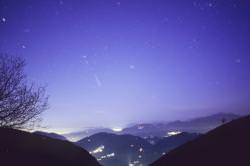What a fantastic month for skywatching. On August 12th, we’ve got the Perseid meteor shower. On August 28th there’ll be a total lunar eclipse. And on September 1st, there might be another meteor shower to enjoy: the Aurigids.
Unlike the dependable Perseids, the Aurigid meteor shower is unpredictable. They’re a stream of particles left behind by Comet Kiess (C/1911 N1). This is a long period comet that has only visited the inner solar system twice within the last two thousand years. Its last visit is believed to have been 83 BC.
On September 1, 2007, the Earth will pass through the dusty trail left behind by Comet Kiess, and it might be a spectacular show. Or it might be a non-event.
“We have so little experience with ancient debris from long-period comets,” notes Bill Cooke of NASA’s Meteoroid Environment Office (MEO) at the Marshall Space Flight Center. “Almost anything could happen—from a fizzle to a beautiful meteor shower.”
Astronomers have predicted that the peak of the shower will occur at approximately 1136 UTC (7:36 am EDT), and last for about 2 hours. It should be visible to observers in Western North America, the Pacific, and Eastern Asia.
One prediction calculated that there could be as many as 100 meteors an hour. That’s pretty good, but not at meteor storm levels, like the Leonids. One unique attribute about the Aurigids is that they leave a brilliant blue-green streak in the sky. Scientists think this might be because Comet Kiess is such a long period comet, spending much of its time in the darkness of the outer Solar System, its particles are relatively untouched by the Sun
So, I can’t guarantee anything. But the weather should still be warm on September 1st. School hasn’t started, and many of you will be looking for an excuse to enjoy the night sky with your friends and family.
Now you’ve got something to do. Go see the Aurigid meteors.
Original Source: NASA Science

